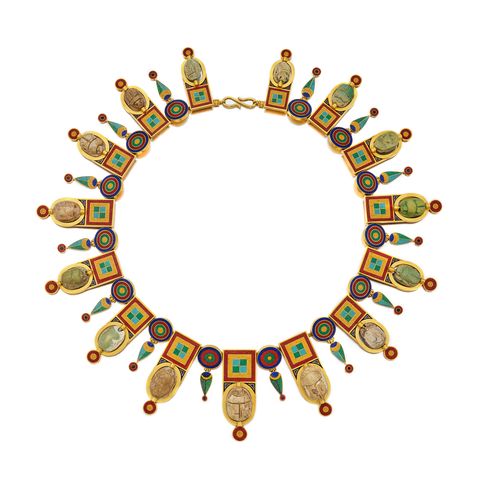
By Stuart Dyer

1960s Hattie Carnegie Egyptian Revival necklace
“It soon became obvious that we were just on the threshold of the discovery. The sight that met us was beyond anything anyone could believe. The amount of material crowded into the chamber without particular order was very bewildering.” An extract from British Egyptologist, Howard Carter’s diary upon discovering the tomb of King Tutankhamen in 1922 – the first intact ancient Egyptian tomb ever to have been found. November 4th, 2022 marks the 100th anniversary of Carter’s discovery which was one of the most exciting archeological finds in history. Even though King Tut was a minor pharaoh, his tomb was filled with over 5,000 glimmering untouched artifacts. The world was riveted and an era of Egyptomania began which inspired the Egyptian Revival period and in turn marked a new era in jewelry design.

Circa1925 platinum, diamond and colored stone bracelet by Lacloche Freres, Sotheby’s
The jewelry created during this period by houses such as Van Cleef & Arpels, Cartier, Boucheron, and Tiffany & Co are some of the finest examples of Egyptian Revival jewelry ever to have been produced. Many of the pieces incorporated motifs and symbols from ancient Egypt such as the Eye of Horus which symbolized healing and protection; scarabs and lotus flowers which represented birth and resurrection; and the Ankh which symbolized eternal life. Sometimes the jewelry designs even incorporated pieces of ancient Egyptian artifacts such as articles made out of faience (the oldest known glazed ceramic) and ancient scarabs.

Illustration of the jewels from King Tutankhamun’s tomb, The illustrated London News, February 26, 1927
Carter’s discovery was not the first to inspire an Egyptian revival. Throughout the ages there have been ebbs and flows in the influence of and interest in the world of ancient Egypt. Other earlier revivals were fueled by Napoleon’s campaigns in Egypt, the 1798 Battle of the Nile, the translation of the Rosetta Stone in 1822 and the opening of the Suez Canal in 1869.

Egyptian-Revival necklace designed by Castellani in the late 1800s. The necklace is included in Sotheby’s upcoming December 7, 2022 jewelry sale.
Throughout the decades, continued explorations of Egypt and archeological discoveries in the region kept a love for all things Egyptian strong. Moving forward into the 20th century a museum exhibition in the 1970s rather than a new discovery or historical event lead to a renewed Egyptian Revival.

People standing in line at Chicago’s Field Museum to see the Treasures of Tutankhamun exhibit in June 1977
From March 3, 1972 until July 19, 1981 a blockbuster museum exhibit called The Treasures of Tutankhamun traveled throughout much of the world. It commemorated the 50th anniversary of the opening of the tomb of Tutankhamun and had 50 objects from the tomb on display. The show could be seen in Great Britain, the USSR, Canada, Germany and six states in the United States. The exhibit even came to the Chicago Field Museum from January 14, 1977 until August 14, 1977. It was the first time that anything from King Tut’s tomb had come to America. No other museum exhibition had ever generated as much attention and excitement and people waited in line for hours to see it. The show set attendance records attracting a total of 8 million visitors worldwide and raising $9 million for the Egyptian government to use in the renovation of cultural venues. Chicago alone had nearly 1.3 million visitors attend the Field Museum’s four-month long exhibit.

Examples of 1970s Egyptian Revival jewelry from Ladybug Vintage
The exhibition caused a fervor for ancient Egypt. Attending the King Tut exhibit was almost like attending a rock concert. There were lines to get in, there was an air of excitement and there was an element of ‘cool’ surrounding the show. People wanted to be a part of it. Costume jewelry companies seized on this opportunity and this time they lead the way for Egyptian Revival jewelry. This was after all the Golden era of costume jewelry. Companies such as Kenneth Jay Lane, Whiting and Davis, Napier, Trifari, Miriam Haskell and Monet produced amazing Egyptian Reviva lpieces. 1970s jewelry design had a penchant for large gold, bold, statement pieces and the Egyptian theme fit quite nicely into this trend. Jewelry using Egyptian motifs and symbols was created and enamels and resins were incorporated to replicate the look of ancient faience and stones. Many of these Egyptian Revival pieces remain quite collectible today. In addition to being fun, irreverent statement pieces, it is fascinating to stop and think about how the jewelry came to be – the way in which a long history of archeology, historical events and travel have influenced their design.

1970s Kenneth Jay Lane Egyptian Revival necklace from Ladybug Vintage |

Examples of 1970s Egyptian Revival jewelry from Ladybug Vintage |
For more Ladybug Vintage, follow @ladybugvintage on Instagram or go to https://ladybugvintage.com/







